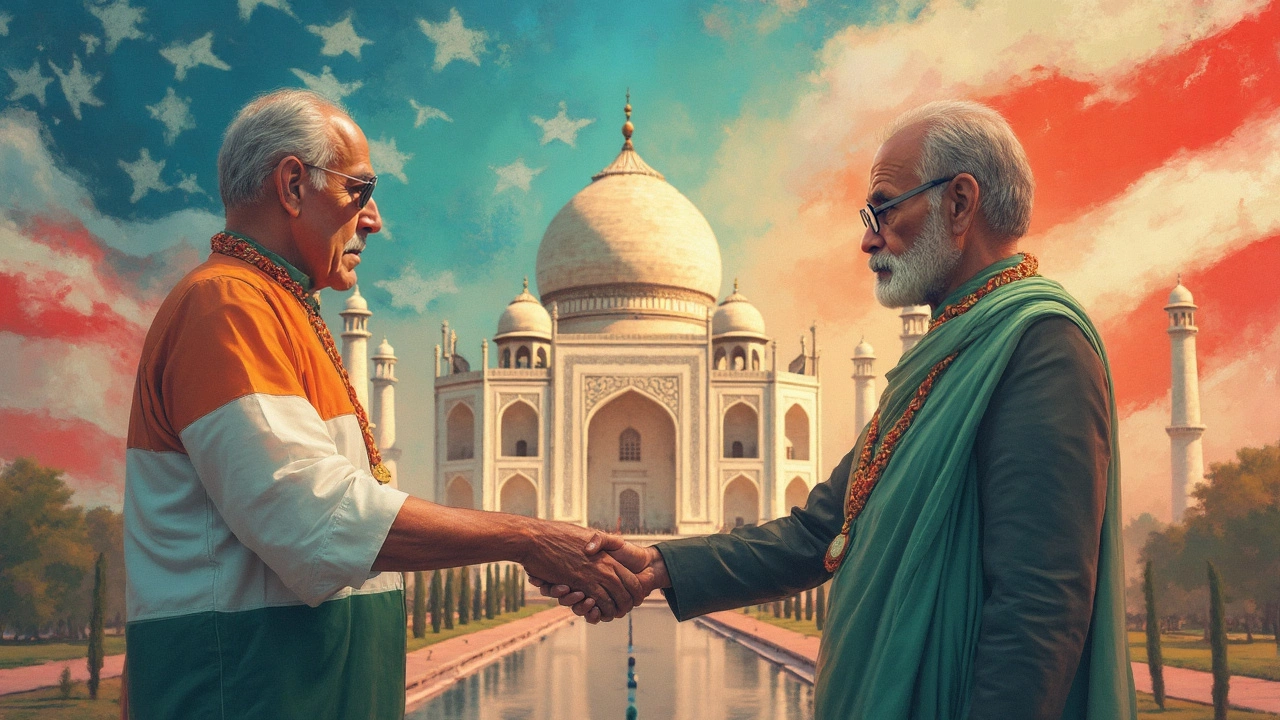
Ever wonder why the US and India are often called friends on the global stage? It’s not just because they both love cricket, movies, and democracy—though those do help! Their relationship is built on a mix of shared values and mutual interests that have evolved over the years.
Back in the day, their common love for democracy set the stage for a deeper connection. They found that cooperating could address some big global issues more effectively. Take climate change, for example—the US and India have partnered up on this challenge, working together on clean energy solutions and aiming for a sustainable future.
But it’s not all about saving the planet. Economic ties are a big part of their friendship too. With trade between the two nations booming, companies and consumers both reap the benefits, leading to a stronger economic partnership. All in all, this friendship is not just beneficial; it’s strategic and purposeful, making it a fascinating topic to explore further.
- Historical Roots of Friendship
- Shared Democratic Values
- Economic and Trade Alliances
- Tech and Innovation Collaborations
- Strategic Military Partnerships
- Cultural and Educational Exchange
Historical Roots of Friendship
The story of why the USA and India are such good friends dates back to when both countries were finding their places in the world. After India gained independence in 1947, both nations found common ground in their democratic ideals. This shared belief in democracy laid the groundwork for a friendship that would evolve over time.
In the early days, the relationships were more about figuring each other out. The Cold War period brought its own set of challenges, with India leaning more towards non-alignment while the United States was fully in the NATO camp. Despite these differences, the two countries maintained diplomatic relations, knowing that there was potential for cooperation.
A significant milestone came in 1962, during the Sino-Indian War. The USA came to India's aid with military support, signaling a deeper level of trust. Fast forward to the 1990s, after the Cold War ended, economic reforms in India opened new doors. The countries began to engage in more robust trade and investment, setting the stage for a strategic alliance.
The turn of the millennium saw a boost in their relationship, particularly with the signing of the US-India Civil Nuclear Agreement in 2008. This agreement allowed for nuclear energy cooperation and was pivotal in strengthening US-India relations. It highlighted the strategic trust and mutual respect between the two nations.
Today, the friendship continues to grow, building on these historical ties and focusing on mutual interests in technology, defense, and global security.
Shared Democratic Values
When it comes to democratic ideals, both the USA and India are like old pals who see eye-to-eye on a bunch of issues. They both have a deep-rooted belief in democracy, which forms one of the main pillars of their friendship. This common ground doesn’t just happen overnight—it’s been growing steadily over the years.
Given that both nations value freedom of speech, diverse cultures, and vibrant political systems, they often find themselves on the same page when it comes to global policies. These similarities aren’t just feel-good factors. They are practical, helping to streamline their diplomatic dialogues and enhance cooperation on the international stage.
Interestingly, these two countries have also backed each other during critical moments. The US has lent support to India’s place in global forums, stressing how important India's voice is in international debates about peace and security. Meanwhile, India frequently backs American initiatives on an array of world issues, from promoting human rights to advocating sustainable development.
Furthermore, there's a mutual respect for one another's democratic institutions, which fuels joint efforts in promoting democracy worldwide. For instance, numerous exchange programs have been launched to help strengthen political systems and civil groups in other nations.
Economic and Trade Alliances
You’ve got to hand it to the USA and India—they’ve built one heck of an economic powerhouse together! These two have been pushing boundaries in the world of trade, and it’s paying off big time. The US India relations in trade aren't just about buying and selling; they’re about creating opportunities for businesses and offering consumers a broad spectrum of choices.
One of the coolest things here is the sheer volume of trade between these countries. In 2023, trade in goods and services between the US and India hit approximately $160 billion. That’s a number that’s tough to ignore! The US has become one of India's largest trade partners, while India ranks among the top 10 for the US. This two-way street not only boosts economies but also supports countless jobs in both nations.
It’s not just about goods; services play a massive role too. From IT services to healthcare, they’re both in this together, setting examples worldwide. They’ve also kicked off several initiatives to make doing business easier, like removing barriers and simplifying regulations, which is a win for everyone involved.
And hey, let's talk investments. American companies like Google and Amazon have been pouring investments into India, leading to job creation and technological advancements. In return, Indian companies like TCS and Infosys are establishing a solid presence in the US, sharing knowledge and skills.
| Year | Trade Volume ($ Billion) |
|---|---|
| 2020 | 122 |
| 2021 | 140 |
| 2023 | 160 |
So, while it might seem like it’s all just about dollars and cents, it’s much more. These economic and trade alliances strengthen their friendship, ensuring stability and growth, making the USA India partnership one to watch!

Tech and Innovation Collaborations
Alright, let's dive into the tech scene. When it comes to technology and innovation, the USA and India have a pretty dynamic partnership going on. It's almost like they're co-authors in a sci-fi novel, crafting the future together. This collaboration has a lot to do with the rise of tech giants and startups in both countries, bridging the gap and boosting each other's innovation capabilities.
Silicon Valley, meet Bangalore! The US is home to some of the world's largest tech firms, like Apple, Google, and Microsoft. Meanwhile, India isn’t far behind with its ever-growing IT industry, producing wiz-kids who are turning startups into unicorns. What's really exciting is how these two powerhouses collaborate on technological advancements.
Let's talk numbers. In recent years, investments from the US into India's tech sector have skyrocketed, illustrating genuine faith in each other's innovative ecosystems. Major tech companies often partner with Indian firms to tap into the country's rich talent pool. In a way, it's like they're building a bridge made of digital code between the two lands.
But it's not just about business. These tech collaborations also focus on education and research. Through numerous bilateral initiatives, students and researchers gain access to diverse learning experiences, pushing the boundaries of what's possible. A shared commitment to cutting-edge research—like artificial intelligence and quantum computing—means they aren't just riding the tech wave; they're shaping it.
Here's a quick snapshot to give you a better idea:
| Collaboration Area | Details |
|---|---|
| AI and Robotics | Joint ventures and researcher exchanges enhancing AI capabilities. |
| Quantum Computing | Collaborative projects pushing tech boundaries in quantum tech. |
So, when it comes to the tech and innovation space, the friendship between the USA and India goes beyond borders and wires. It's about sharing ideas and building a future where tech can solve real-world problems. Exciting times, right?
Strategic Military Partnerships
When it comes to strategic military friendships, the bond between the USA and India packs a punch. And why shouldn’t it? Both countries know the importance of staying prepared, especially with a changing global landscape. It's not just about safeguarding borders; it's about fostering regional peace and stability.
Over the years, they've rolled out several agreements. One significant milestone was the Logistics Exchange Memorandum of Agreement (LEMOA), allowing each country to access the other's military facilities for repairs and supplies. This agreement alone made coordination during joint exercises a whole lot smoother.
Speaking of exercises, have you heard of the Malabar Exercise? It’s an annual naval drill involving the US, India, and countries like Japan and Australia. This exercise isn't just a meet-up; it’s major training boosting teamwork across navies, which can be crucial in real-world scenarios.
Another highlight is the Communications Compatibility and Security Agreement (COMCASA), which enhances India’s access to advanced defense technology from the US. This means better hardware and clearer communication—key ingredients for operational efficiency.
US-India relations are not just limited to defense deals. There's a technological collaboration angle as well. With partnerships in cyber defense and space technology, both countries are well-prepared to face modern challenges. It's an inclusive approach combining defense and innovation, enabling India to ramp up its defense capabilities while keeping friendly ties.
They also tackle non-traditional military issues like piracy and terrorism together. This broad focus not only strengthens individual countries but also adds to global security—making the world a little bit safer for everyone.
Cultural and Educational Exchange
When it comes to bonding, nothing beats sharing culture and education between countries like the US and India. Their friendship has been strengthened by how they exchange ideas, traditions, and brainpower.
First up, let's talk culture. The US is crazy about Indian cuisine, yoga, and Bollywood films. You've probably noticed how Indian festivals like Diwali are celebrated across American cities. In return, Hollywood movies, pop music, and fashion trends have made their way into Indian lifestyles, pulling people closer than ever.
Education is a big player in this relationship too. Indian students flock to American universities, with more than 200,000 Indian students enrolling each year, making them the second-largest group of international students in the USA. They bring a fresh perspective and contribute significantly to academic research, especially in fields like technology and business.
On the flip side, many Americans pursue education in India to dive into its rich historical and cultural studies, something not found elsewhere. This exchange helps both sides understand each other better and foster innovation.
The cherry on top? Joint educational programs and scholarships. Initiatives like the Fulbright-Nehru program offer scholarships that allow students and professionals to study abroad, reinforcing this bond. With each student, a bridge of understanding is built, creating pathways for collaboration and lifelong connections.